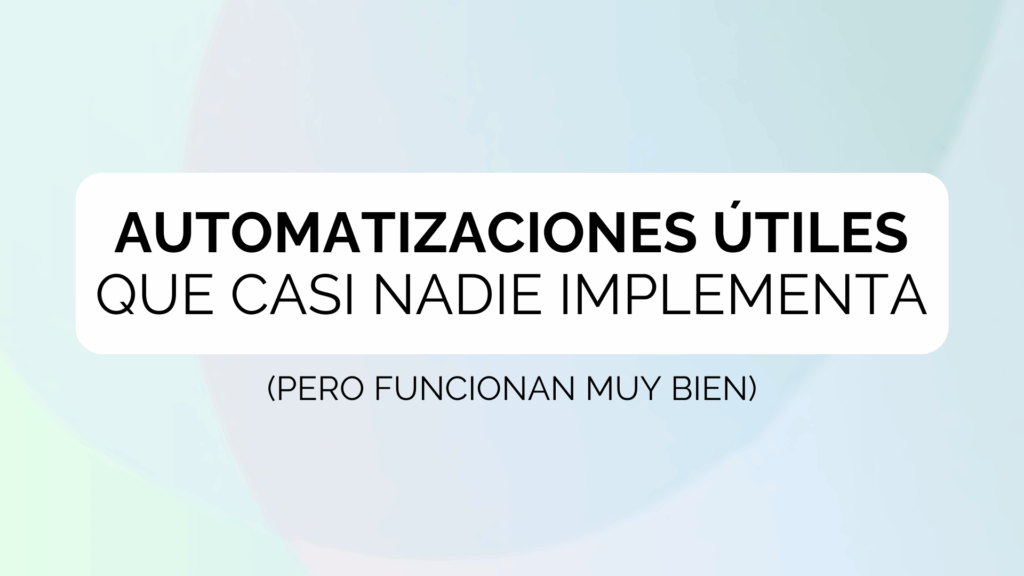Useful automations that hardly anyone implements (but work very well)

In email marketing we tend to think of "manual" automations: the welcome, the abandoned cart or the reactivation of inactives. They are basic and they work, yes, but there is a range of less common automations that, if well executed, offer enormous potential to improve the customer experience and multiply returns.
In this post, we share with you 7 little exploited but very effective automations:
1. Post-purchase emails based on type of product purchased
The purchase confirmation email is usually cold and standard. However, customising it to the product purchased turns a transactional communication into an opportunity to add value..
Examples of application:
- If a customer buys a face cream, send them an email with application tips and frequency of use.
- If they buy running shoes, suggest technical socks or running accessories.
- If you buy an appliance, send them a short video of installation or maintenance recommendations.
BenefitThe customer perceives attention to detail, receives useful content and increases the likelihood of repeat purchases thanks to cross-recommendations.
2. Reminder of points or benefits in loyalty programmes
Loyalty programmes often fail for lack of timely reminders. Customers forget that they have accumulated points or are unaware of how close they are to their next reward..
Automation ideas:
- Automatic email when the user reaches the target 80% to get a coupon.
- Reminder with only a few days to go before the expiry of points.
- Monthly updates with the balance of points and benefits available.
BenefitThe loyalty programme is a great way to reactivate interest, encourage repurchase and generate more engagement with the loyalty programme.
3. Anniversaries and special dates beyond birthdays
The birthday email is a classic, but few brands take advantage of it. other relevant dates that also generate emotional impact.
Some options:
- Anniversary of first purchase (with a special discount or token gift).
- "X" months since subscribing to the newsletter (thank you for your loyalty).
- Reminder that you bought your favourite product a year ago, inviting you to renew or try the latest version.
BenefitThese communications transmit closeness and attention, making the customer feel valued in a personalised way, beyond the obvious.
4. Replenishment recommendations
Many products have a predictable consumption cycle: cosmetics, food supplements, hygiene products, printer inks and so on. If you know that a customer usually takes 30 days to finish a cream or 90 days to need a refill, automating the reminder is key.
Practical example:
"It's been 30 days since your last vitamin purchase. Do you want to reorder before you run out?" with a quick buy button.
Benefit: you reduce repeat purchase friction, increase recurrence and make your brand the most convenient option over the competition.
5. Last chance" email on product navigation
The abandoned cart is one of the star automations, but what about those who visit products without adding them to the cart? These users show intent, even if they have not yet taken the next step.
How to apply it:
- Email with the most recently viewed product and a call to action to retake it.
- Offer a subtle incentive ("Stock of this product is limited" or "Other customers are buying it now").
- Recommend similar products if you don't want to be too aggressive with the reminder.
BenefitYou win back a very hot segment that is often neglected, increasing sales without the need for heavy discounting.
6. Feedback after customer service interaction
Customer care often generates valuable interactions, but many brands don't take advantage of them to learn and improve. An automation that asks for feedback right after closing a ticket or resolving a query can make all the difference.
Example:
- Email with a single-question satisfaction survey (NPS or CSAT) after the interaction.
- Thank you message if the score is positive, or refer to the support team if the experience was negative.
BenefitIn addition to showing interest in the customer's opinion, this practice makes it possible to detect faults, improve processes and increase the perception of closeness and care.
7. Automatic segmentation by content affinity
Email engagement can be turned into an automatic segmentation engine. If a user repeatedly opens or clicks on a specific category, it is possible to automatically tag them in an affinity segment.
Example:
- If someone interacts more with "sports shoes" emails than with others, they are automatically added to the sport.
- If another user always opens the emails from outlet offersIf you are interested, you may receive further discount-oriented communications.
BenefitImproves the relevance of submissions, increases open and click-through rates, and reduces the risk of fatigue from sending uninteresting content.